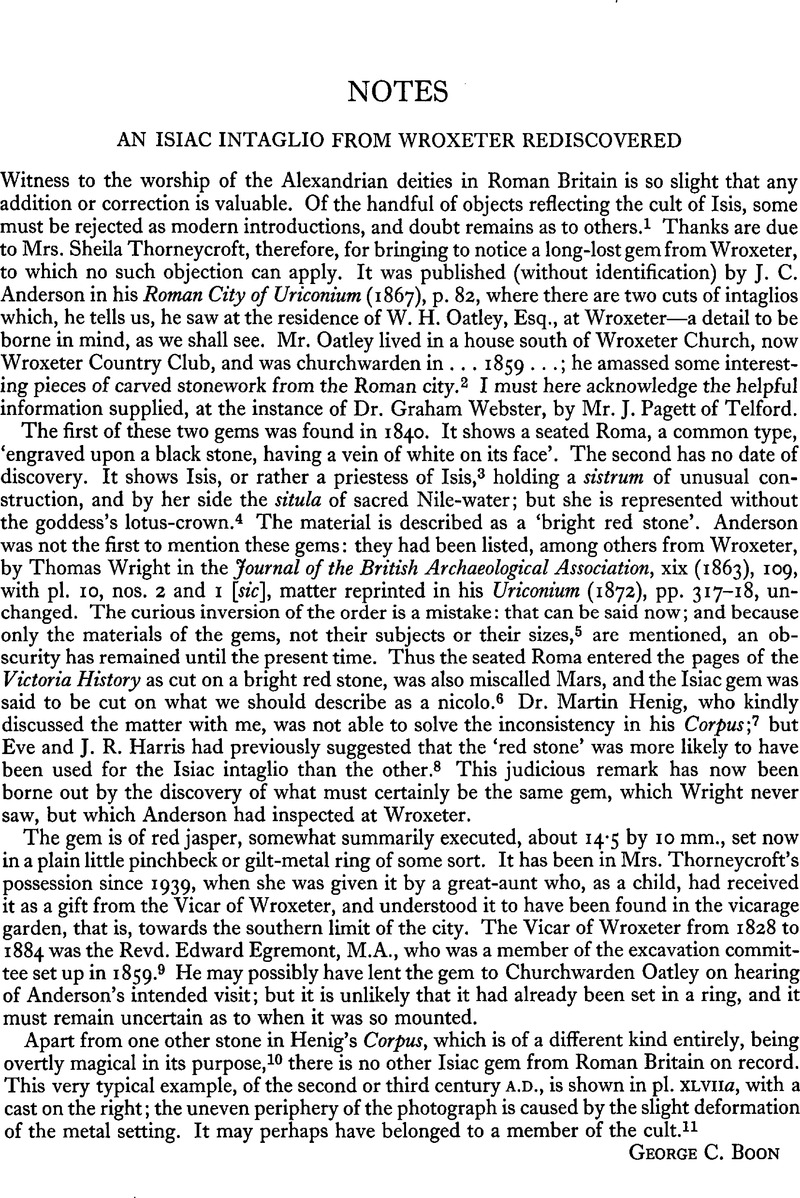Article contents
An Isiac Intaglio from Wroxeter Rediscovered
Published online by Cambridge University Press: 29 November 2011
Abstract

- Type
- Notes
- Information
- Copyright
- Copyright © The Society of Antiquaries of London 1982
References
Notes
1 The fundamental discussion still remains that of , E. and Harris, J., Oriental Cults in Roman Britain (1965), pp. 74–95, Isis at pp. 79–81.Google Scholar See also Toynbee, J. M. C., Art in Britain under the Romans (1964), pp. 95–6.Google Scholar Cf. Green, M. J., The Religions of Civilian Roman Britain (B.A.R. no. 24, 1976), p. 58Google Scholar; and ead., Small Cult-Objects from the Military Areas of Roman Britain (B.A.R. no. 52, 1978), p. 28.Google Scholar The reader will have to make up his own mind as to which of these various objects he is willing to accept as ancient, and which as modern, introductions; moreover, some of the identifications are wrong. The Highworth (Wilts.) Sarapis-head did not come from a grave, and beyond much doubt was a relic of a visit to Egypt in modern times. The Exeter sistrum-model in faience is older than Roman Britain, but is a modern introduction likewise, as Bidwell shows in his Roman Exeter (1980), pp. 82–5. The Chester figurine (Archaeologia, cv (1975), 195, no. 41Google Scholar) is not Harpocrates, but an amulet against evil influences entering the body, hence hand on mouth and anus [only the latter position clear in the drawing]: there is one similar from Caerleon (unpubl.), and one from Worcester (Victoria History, 1 (1901), p. 206Google Scholar, fig. 2); several abroad. Considering the evidence for Christianity, that for the mystery religions at an earlier date is very curiously weak, apart from Mithraism in the military zone. To it may possibly be added the fragments of bottles of Egyptian alabaster found at Caerwent, and Silchester, (Bull. Board of Celtic Studies, xxix, 2 (1981), 354–6)Google Scholar paralleled in the Rhineland (ibid., xxix, 4, 847–9), which, to offer a suggestion, may have held Nile-water for libations; cf. Witt, R. E., Isis in the Graeco-Roman World (1971), pp. 91–2.Google Scholar
2 Anderson, op. cit., 49, pl. 8; Wright, T., Guide to the Ruins of … Uriconium (1859), pl. 6.Google Scholar
3 Delatte, A. and Derchain, P., Les intailles magiques gréco-égyptiennes (1964), p. 83.Google Scholar
4 Sistrum, shaped usually (as it were) like a tennis-racquet with three bars passing from side to side; here the bars appear to pass through a single upright and to have large T-shaped ends. Cf. Witt., op. cit. (note 1), pl. 35, Antioch mosaic, in contrast with pls. 31–2. Crown: ibid., pl. 6, for the goddess (with) and pls. 31–2 for priestesses (without).
5 The engravings given by Wright and (hence?) Anderson are about one and a half times natural size, judging from the original stones (the Roma is in Shrewsbury Museum).
6 The Victoria History of Shropshire, 1 (1908), p. 255, figs. 28–9.Google Scholar
7 Henig, M., A Corpus of Roman Engraved Gemstones from British Sites (B.A.R. no. 8, 1974, repr. 1978), nos. 251, 359.Google Scholar
8 Loc. cit.
9 Wright, op. cit. (note 2), p. 90. See also p. 74.
10 Henig, op. cit. (note 7), no. 369.
11 To the references cited by Henig under no. 359 add a few in the series Antike Gemmen in deutschen Sammlungen: 1, 3 (München), no. 2661, red cornelian; III (Braunschweig–Kassel), no. 77, red jasper; IV (Hannover), no. 1698, black jasper. The type is seen to be a rare one even in large collections.
- 2
- Cited by




